-
Car Reviews
- All reviews
- Midsize SUVs
- Small cars
- Utes
- Small SUVs
- Large SUVs
- Large cars
- Sports SUVs
- Sports cars
- Vans
Latest reviews
- Car News
-
Car Comparisons
Latest comparisons
- Chasing Deals
Can one vehicle do double-duty as a 340kW performance monster and a part-time electric SUV? Volkswagen’s new Touareg R audaciously attempts the task
“Two point four tonnes!” I just about spat out of my mouth after being informed of the mass of the 2024 Volkswagen Touareg R – notably after a lengthy, spirited drive through the Victorian high country.
That surprise followed a properly entertaining punt that showed the plug-in Touareg R handles like a car at least 20 percent lighter and 20 percent smaller.
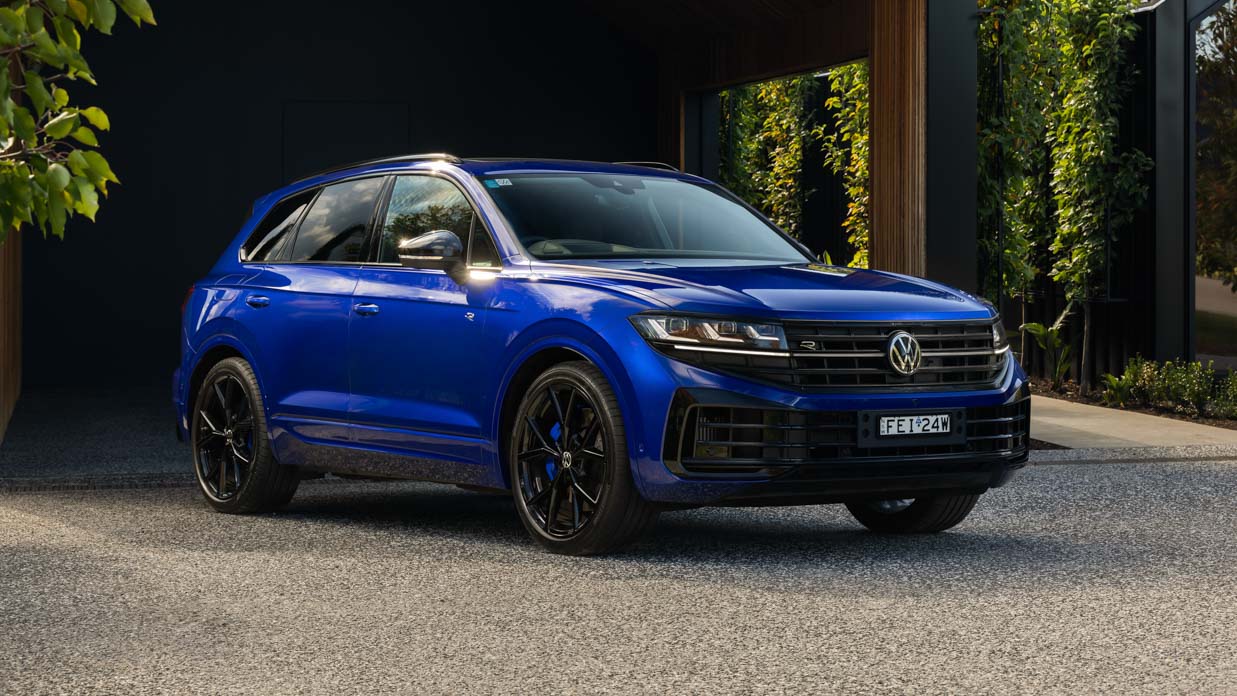
From previous tests of the diesel models, we already knew the Touareg was sweet – but the audacious Touareg R, which adds a complex plug-in hybrid system to a petrol V6 – should feel compromised. It doesn’t.
While it’ll pootle along in town tapping into its rechargable 51-kilometre all-electric range, the Touareg R is shockingly capable on technical B-roads that would well-suit a BMW M3. It was enough to turn your mind to the idea that a PHEV crossover could even be good on track.
The recent facelift of the Touareg large SUV was accompanied by a price cut for the diesel V6 models. While the Touareg R is the most expensive of the lot – and a new addition for Australia – Volkswagen insists the model’s value for money play applies to the R too.
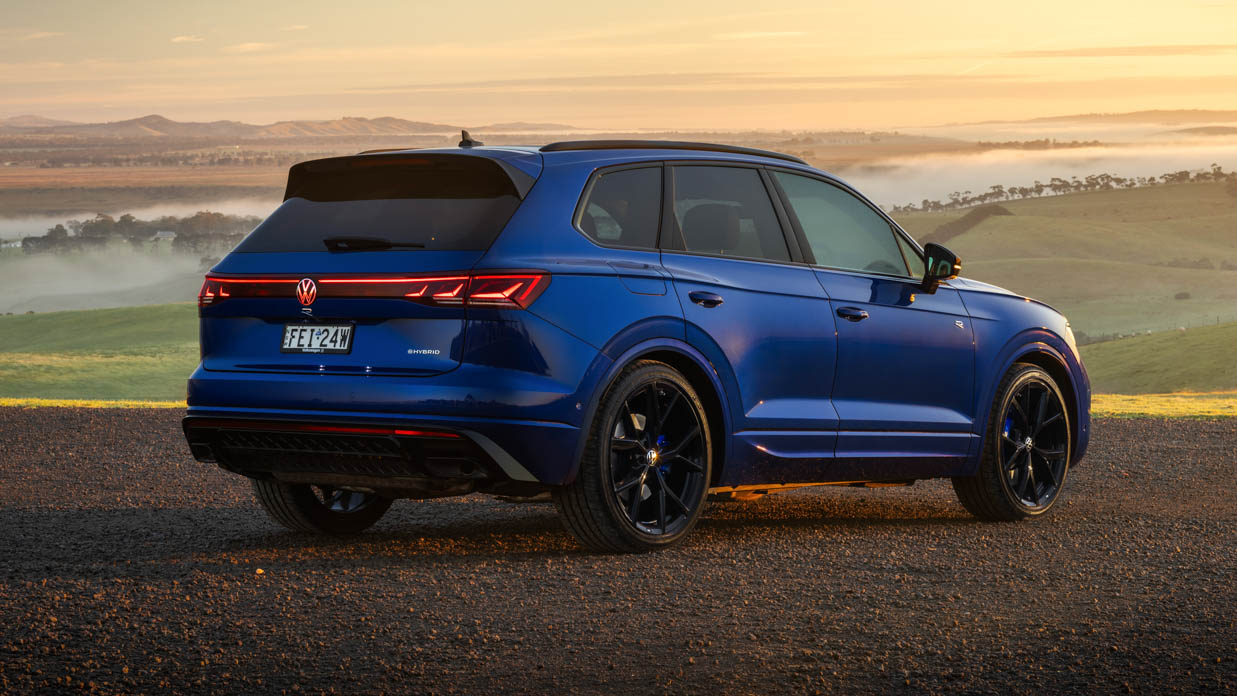
Priced at $129,990 before on-road costs, the Touareg R is likely to be a fairly niche proposition, but Volkswagen is keen to point to its previous performance model in the V8 Wolfsburg Edition which cost $139,990 back in 2021.
Unlike other Touaregs, the plug-in R makes use of a petrol V6, albeit with the same 3.0L displacement as the non-hybrid diesels. Peak power for the engine alone – say, when there is no charge left in the battery – is rated at 250kW at 2500rpm and 450Nm from 1500 to 5300rpm.
Backed up by a 100kW/400Nm electric motor mounted snuggly between the engine and the eight-speed torque converter transmission, the maximum 340kW/700Nm outputs are immense.
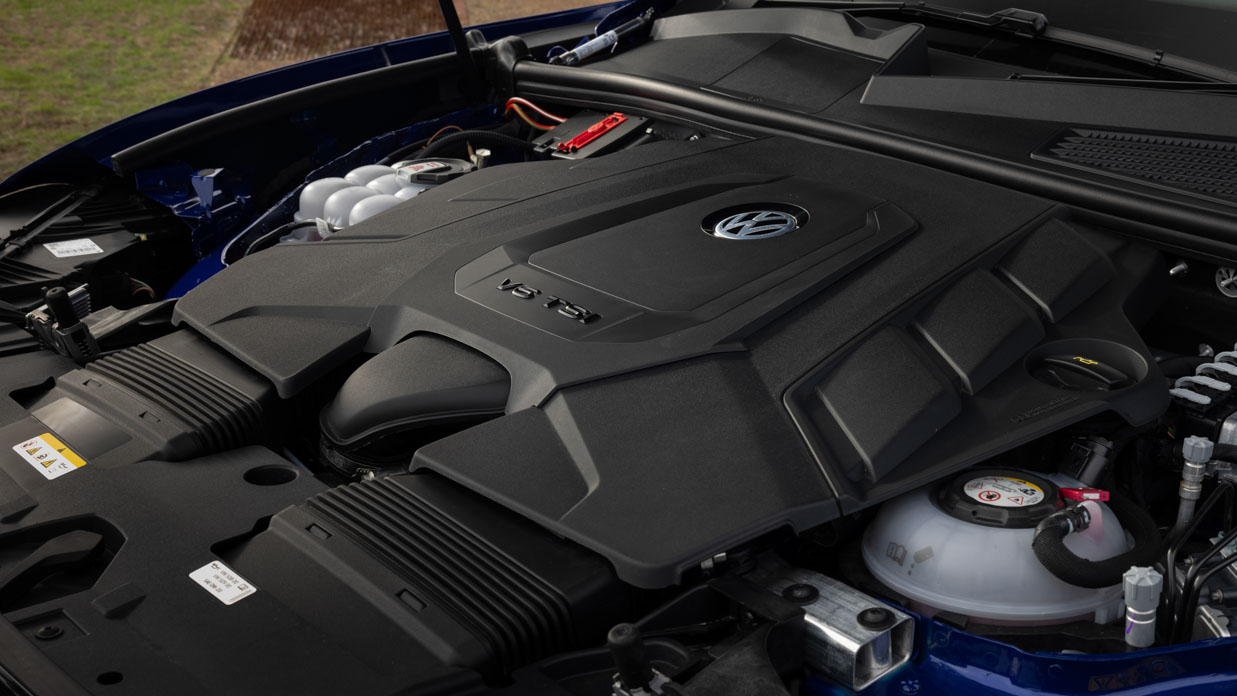
That torque figure is technically down on the 310kW/900Nm put out by the lusty twin-turbo V8 diesel of old but the 340kW power output makes it the most powerful Volkswagen ever produced.
The Touareg R shares its platform and its entire hybrid V6 drivetrain with the Audi Q8 60 e-TFSI PHEV that costs a substantial $22,510 more than the VW ($152,500) while offering a more laid-back luxurious experience with a sleeker rear roofline.
In terms of acceleration from a standard start to 100km/h the Touareg R takes 5.1 seconds – 0.9 seconds quicker than the 210TDI version, though the old Wolfsburg V8 diesel actually had a stronger claim of 4.9 seconds.
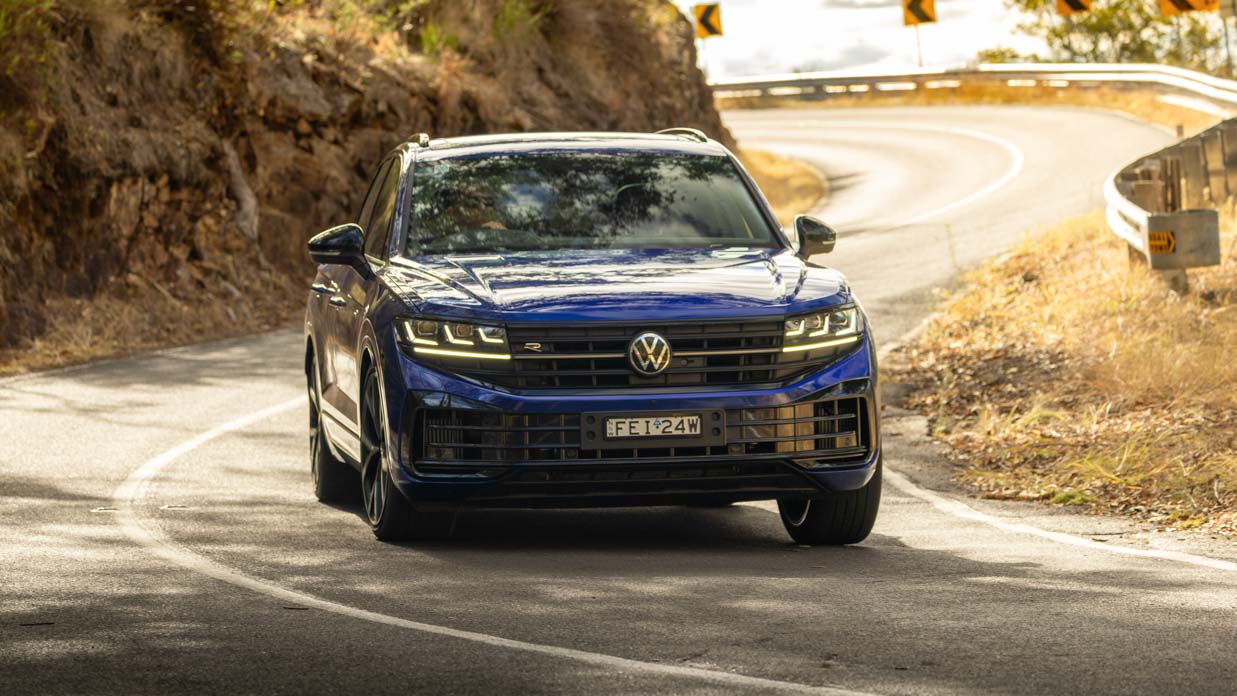
The difference between those engines and this petrol-electric mongrel is response time, first from the electric motor and then from the turbo V6, which makes for a fierce corner exit once combined with the surefootedness of that all-wheel-drive system.
The electric-assisted throttle response is snappier in the plug-in petrol when compared to the lusty but laggy V8 diesel (let alone the V6, which is still a little lethargic initially).
Winding through backroads, taxing the engine, motor, 285mm tyres and six-pot front brakes, it is easy to get into a natural rhythm with this car – a rarity for even sporty SUVs.
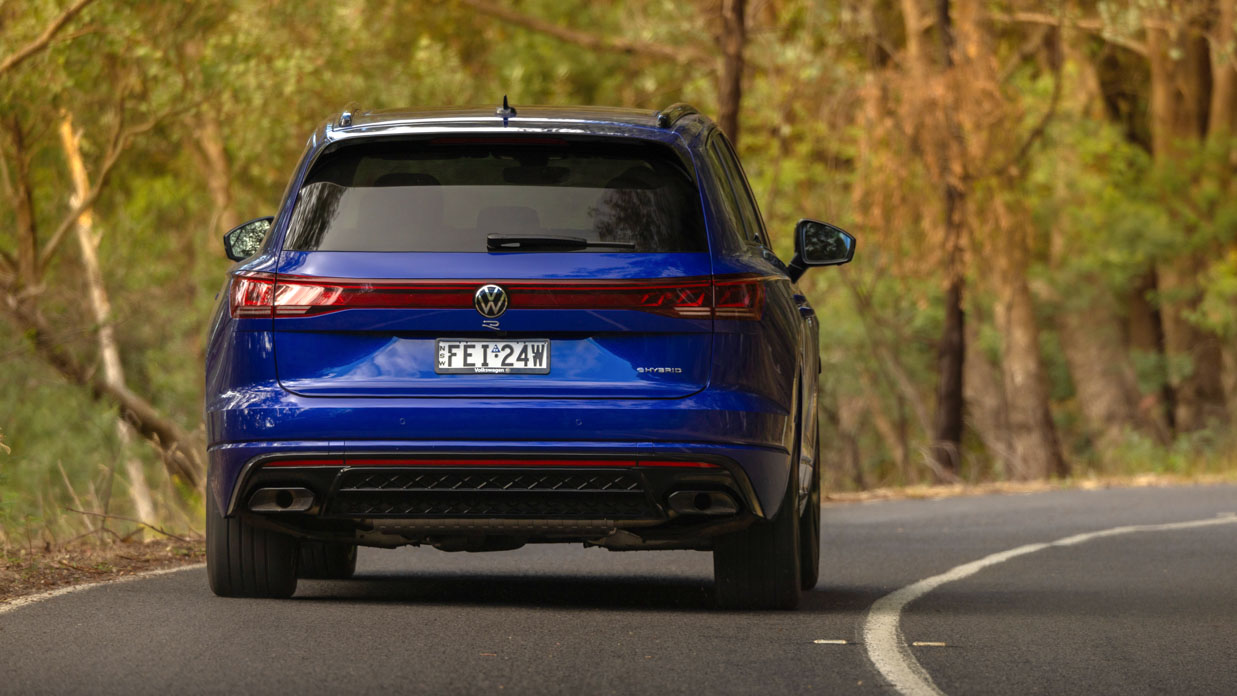
The underlying dynamics are impressive for a 2.4-tonne vehicle, though the capability is not unlimited. Keep pushing hard and you’ll eventually locate hesitation from the front end.
Still, you’d have to spend far more on something like a BMW X5 xDrive40i (from $138,900) to nab a better-driving large SUV, and that’s not a plug-in hybrid – you’d have to spend $149,900 before costs to find a PHEV X5 on your driveway.
After setting off with half of the battery charged, it was pleasing to see the Touareg R actively recouping energy while braking – meaning it’s loaded-up and ready to deploy electric power when you exit the corner. You can palpably feel the hybrid system bolstering the V6.
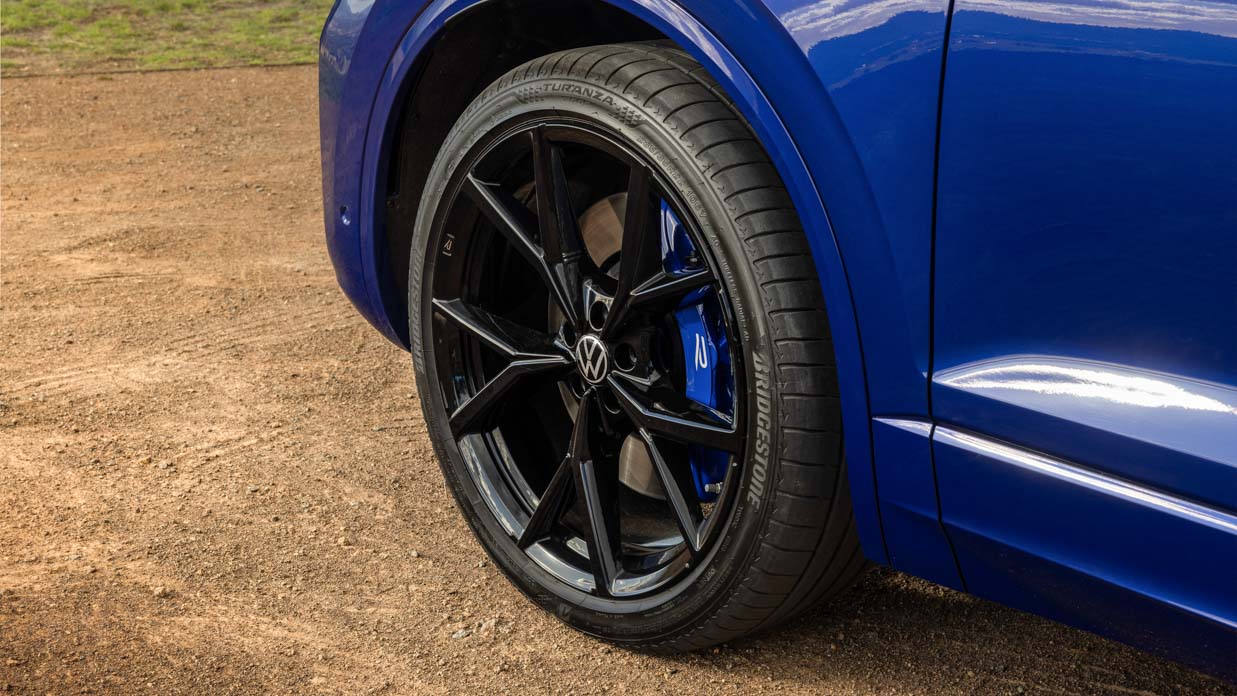
Even when the battery slowly whittles down after a while, it’s designed to always keep some juice locked away for a sudden acceleration burst when you need it.
It must be said though, the V6 is no V8 when it comes to aural spirit. The R sounds fine enough; the noises the six-cylinder engine makes are pleasant and fulsome but it does lack the snarl many associate with a bigger V8 unit.
A casualty of the 14.3kWh usable (17.9kWh gross) lithium-ion battery mounted over the back axle is that the Touareg R forgoes the rear-wheel-steering fitted to the R-Line, as well as the active 48-volt anti-roll bars that we have found really do heighten body control where fitted on Audi’s fast SUVs.
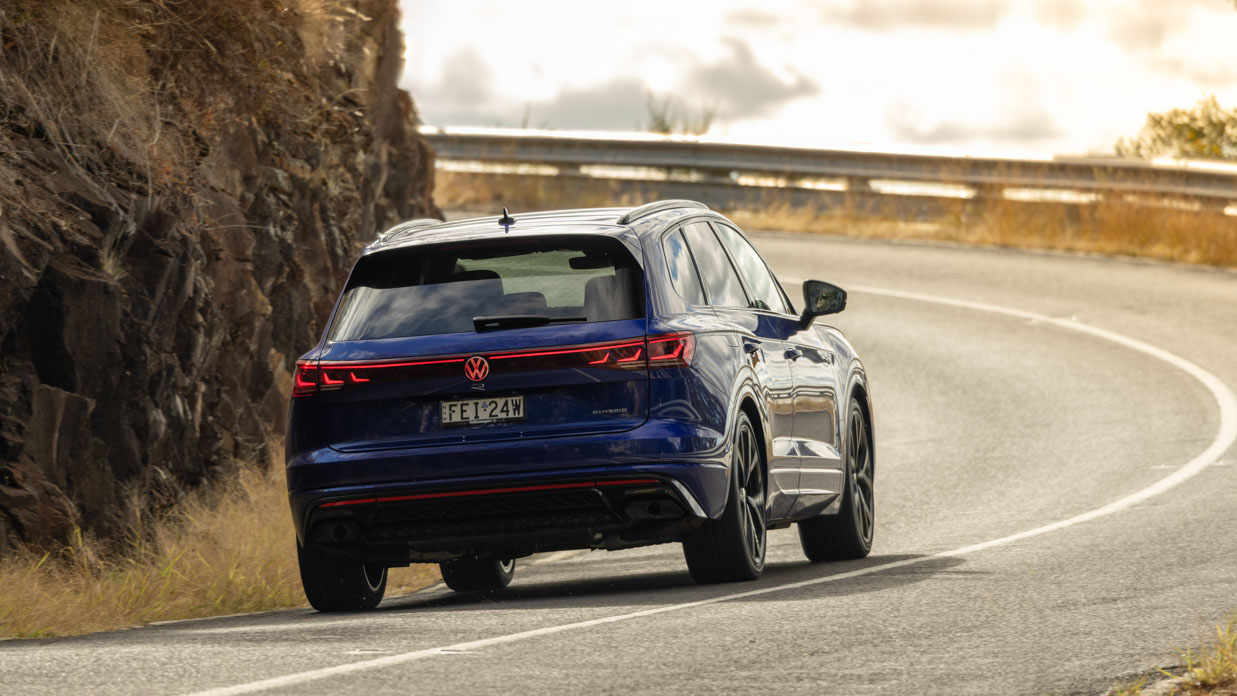
Yet, even without the trick 48-volt tech, the Touareg R’s body control still took me by surprise as the four-corner adaptive air suspension is competent at managing the weight.
Still, our previous tests of the related, non-hybrid Audi SQ7 (from $175,400) revealed that, where fitted, the active anti-roll bars lift body control to even higher levels. We have tested SQ7s both with and without the system.
It’s a conundrum with the Touareg, because the 210TDI R-Line model with the V6 diesel does get the trick anti-roll bars. So, while the plug-in Touareg R is excellent, could the cross-country pace of a 210TDI R-Line be even better? It’s possible.
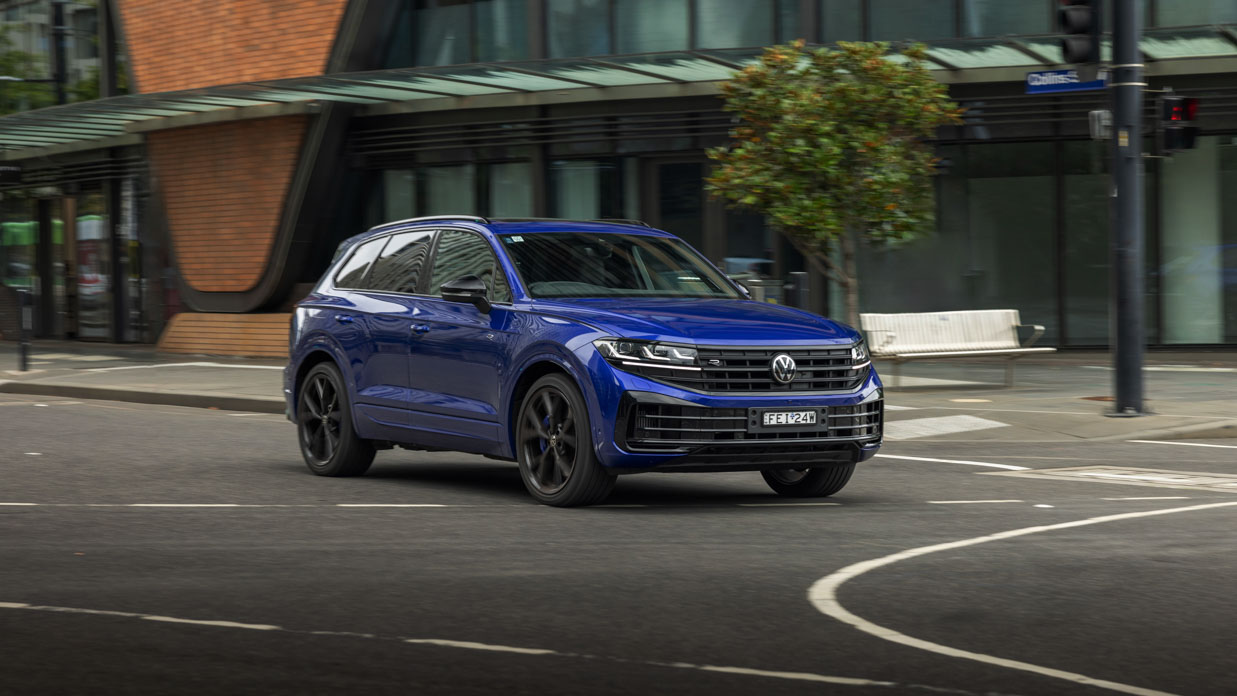
Still, backroad-blasting in a family bus isn’t the most common of activities – so we headed into town to assess the hybrid R’s capabilities on the everyday commute.
Presented with a fully charged battery and a very Melbourne mission to retrieve coffee and breakfast, we set off to mingle among morning traffic across a burst of highway and then through suburban backstreets.
With the near-silent electric motor exclusively driving power to the wheels and the well-insulated cabin, the Touareg was extremely quiet against the rowdy morning traffic. Peaceful, even.
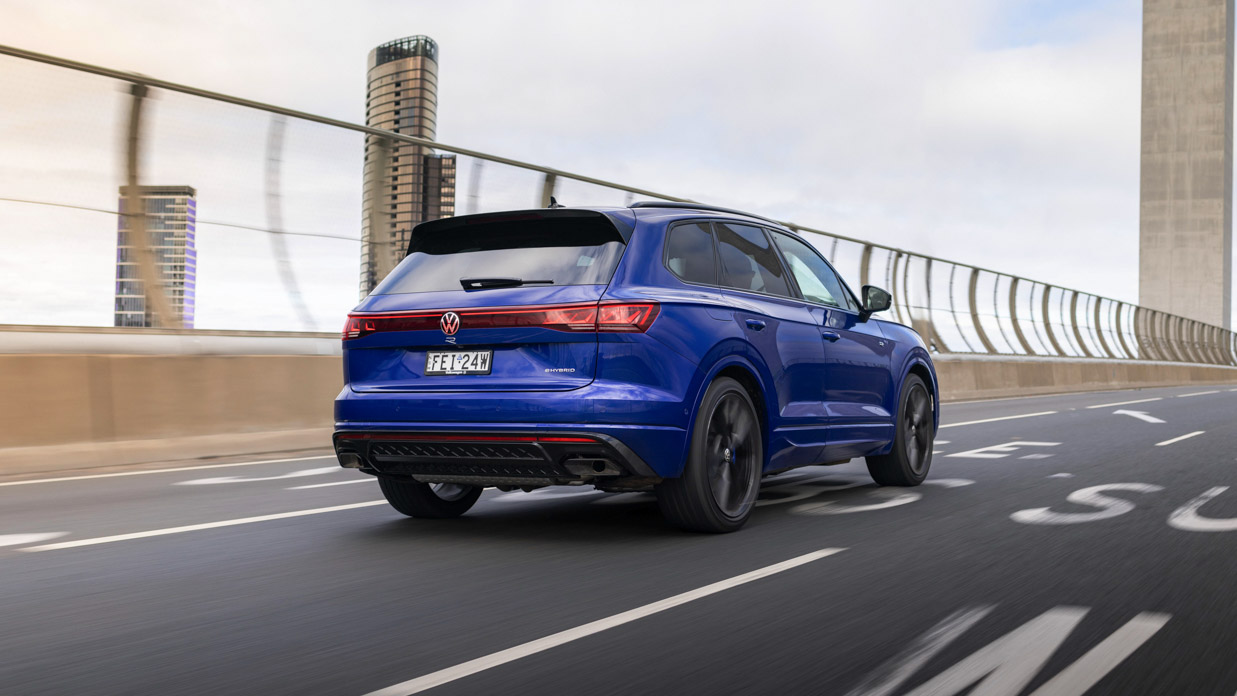
The air suspension system of the Touareg R does a stand-up job of ironing out the bumps (possibly quite literally, given the weight), especially given its low-profile, 22-inch wheels.
For 43 kilometres we drove on electric power alone, with the engine not kicking in until the final 600 metres of our trip. Against Volkswagen’s claim of 51km electric range, that isn’t bad at all – though the consumption of 33kWh/100km is pretty thirsty compared to a full EV.
We think we could have eked out a bit more with judicious use of the throttle and accessories – but come on, it’s a full-fat, full-luxury R product…
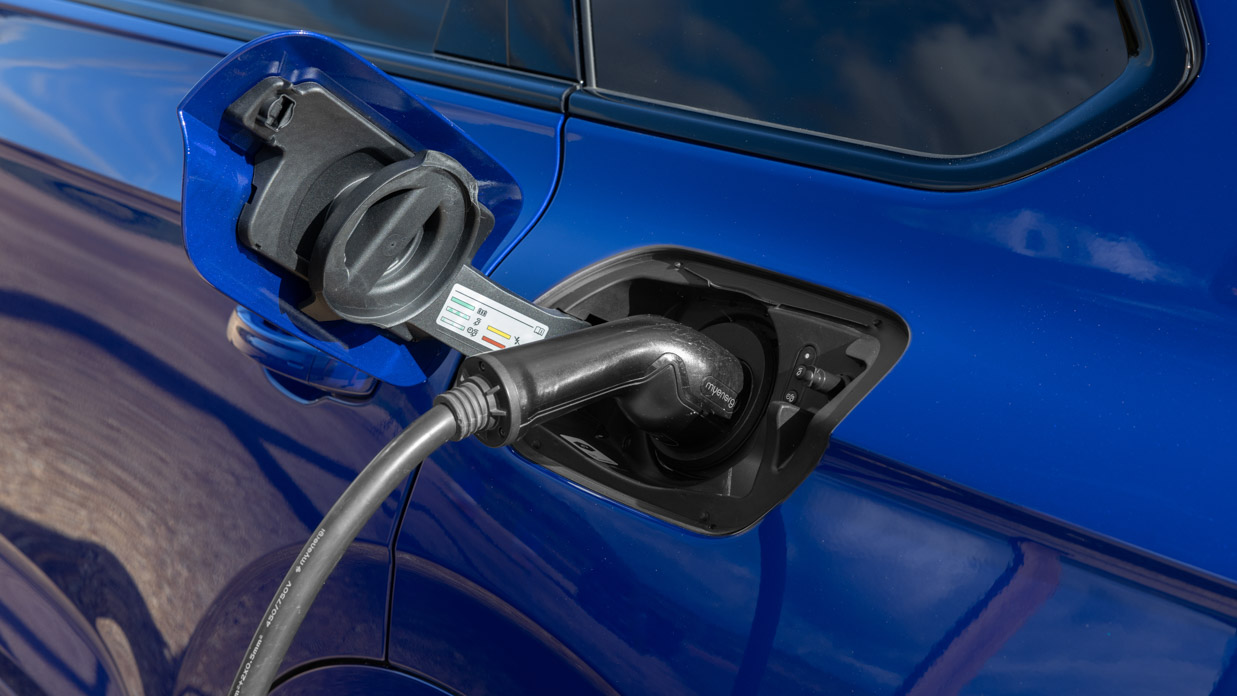
For buyers who have the means to charge at home – which would be many people considering a luxury vehicle like the Touareg R – charging can be done overnight and replenishes that 43km-plus range for a cheap, quiet, eco-friendly commute.
That’s the useful purpose of splurging on the Touareg R. If you’re not going to charge it regularly, the diesels will make much more sense financially, and possibly ecologically too.
It is worth noting that the Touareg does not join newer PHEV models that offer DC charging as well as AC charging – even Mitsubishi’s Outlander plug-in does this – but the use case of a PHEV really is short-distance electric running.
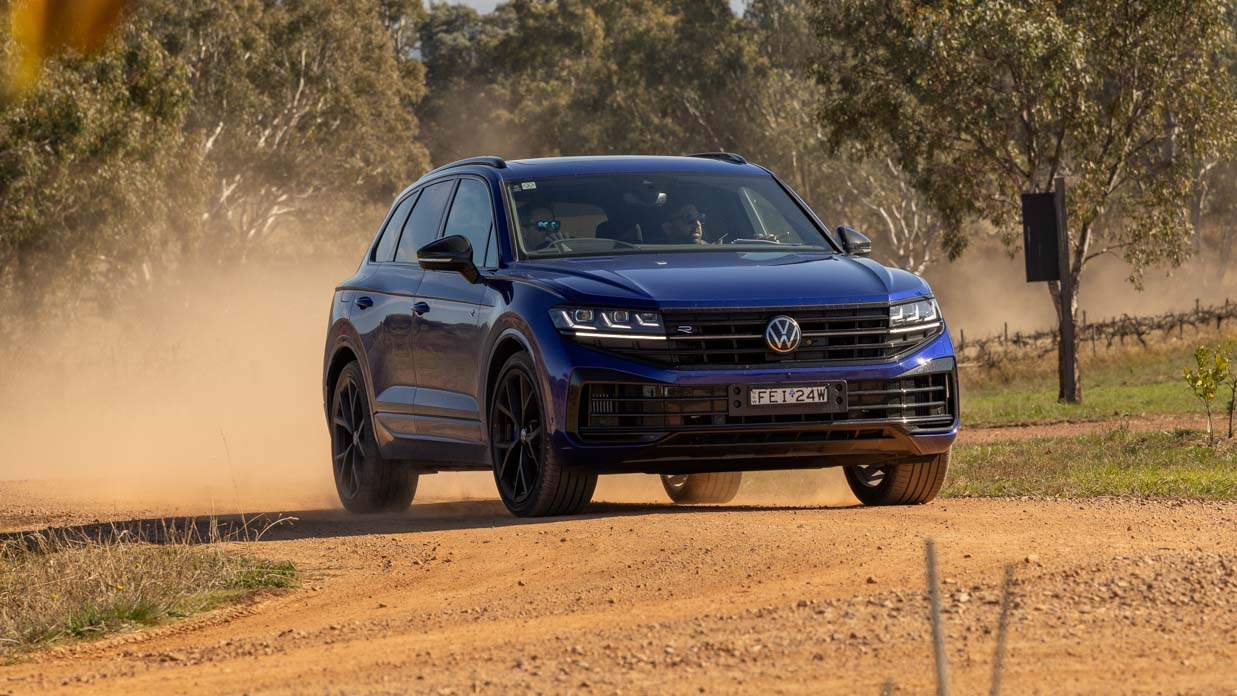
When you run out of electric range and start tapping into the petrol engine, realistic fuel consumption will be around the 10L/100km mark, though a full and independent test of this element is forthcoming. On the car’s national launch, we did what we could.
The official combined claim is 3.3/100km but this is largely meaningless as the standardised figure assumes you are only driving for 100km, and have a fully charged battery every time.
Certainly, an uncharged Touareg R will drink more fuel than the diesel models, which happily return 6-8L/100km without any electric assistance.
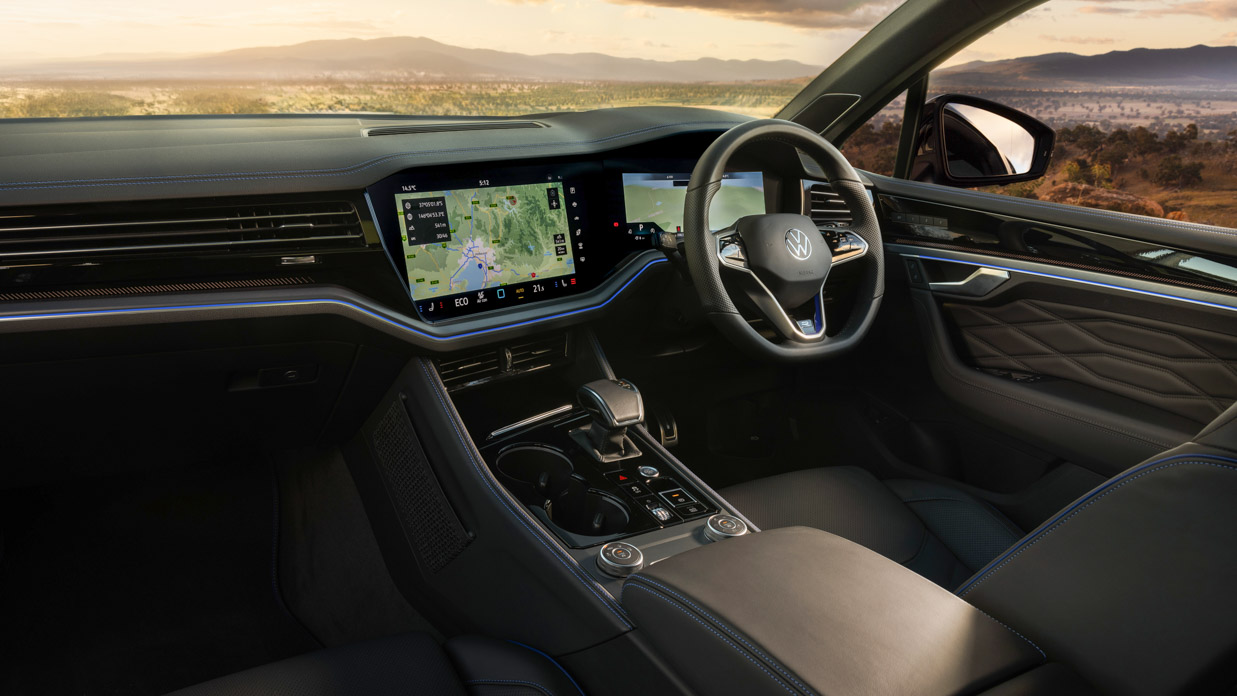
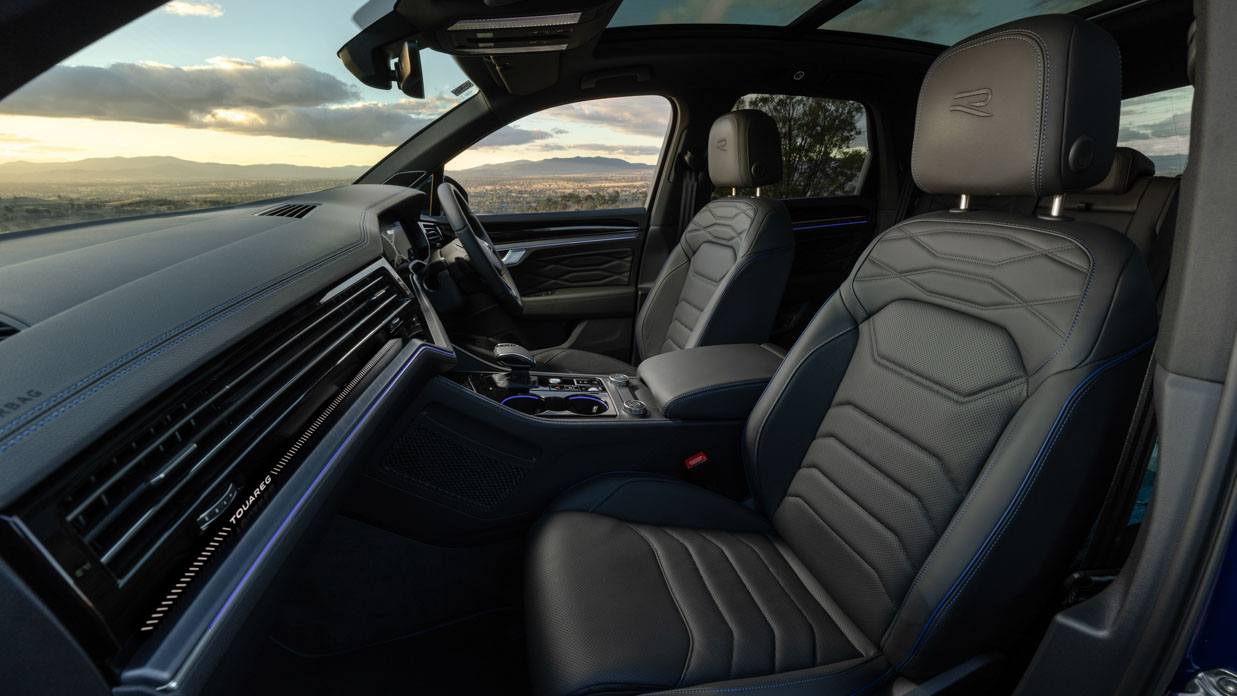
Outright range is still good – but again, for buyers doing serious miles regularly, the diesel will be a better fit. The TDI models have a 90L fuel tank with 1000km-plus range, while the Touareg R’s capacity is cut to 75L for about 750km of driving potential between stops.
Heading inside, the cabin of the Touareg R is suitably luxurious – as you’d expect at this price – with leather-appointed seats with 18 degrees of adjustability, heating and cooling as well as a massage function all fitted as standard.
Standard-fit equipment includes a head-up display, a 12.3-inch digital driver’s display, a litany of USB-C ports, a wireless phone charger and IQ Light matrix LED headlights.
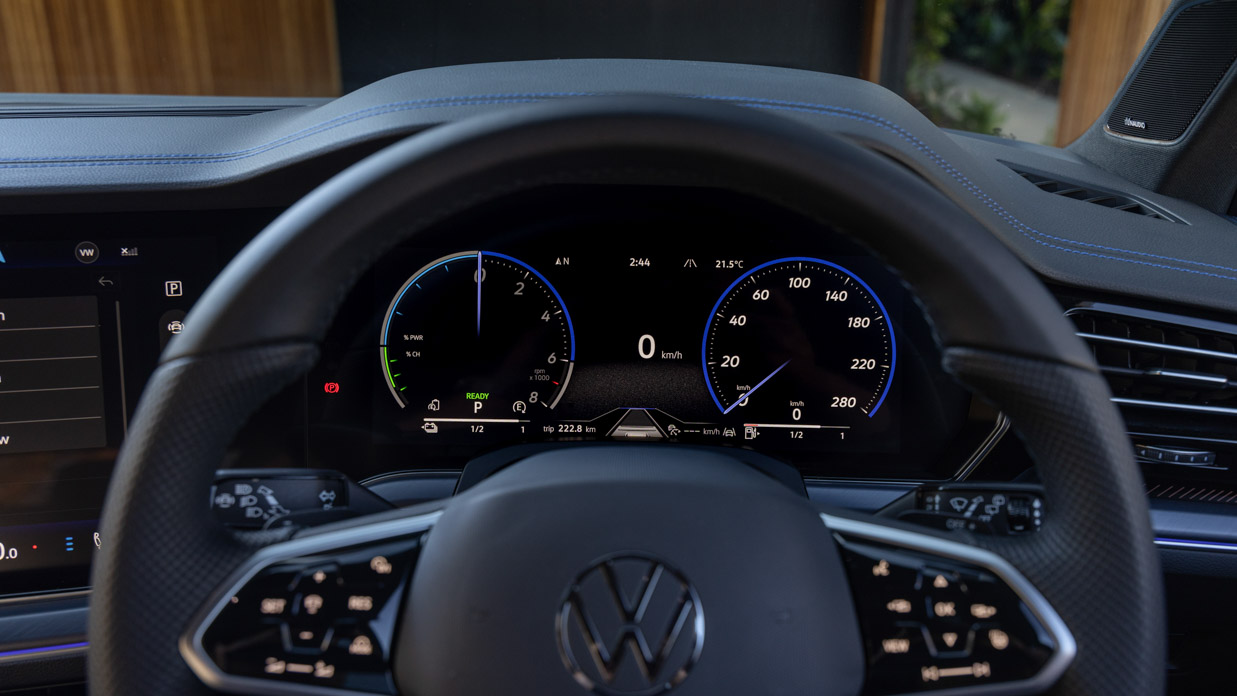
Little tackers in the back will also benefit from a panoramic sunroof, four-zone climate control, heating for the rear outboard seats, pull-up sunshades and a crisp 14-speaker Dynaudio system that I found to be rather pleasant through a range of music types.
Even if you want to seat adults in the rear, the larger dimensions that make life difficult in multi-storey car parks pay dividends for the interior space. I had no trouble sitting behind my own driving position at 183cm tall.
The 15.0-inch touchscreen fitted to some grades of the pre-facelift Touareg had a reputation for being big, but also little lacking in functionality. The engineers have rejigged this unit, adding wireless CarPlay and Android Auto, while making the screen standard across the range.
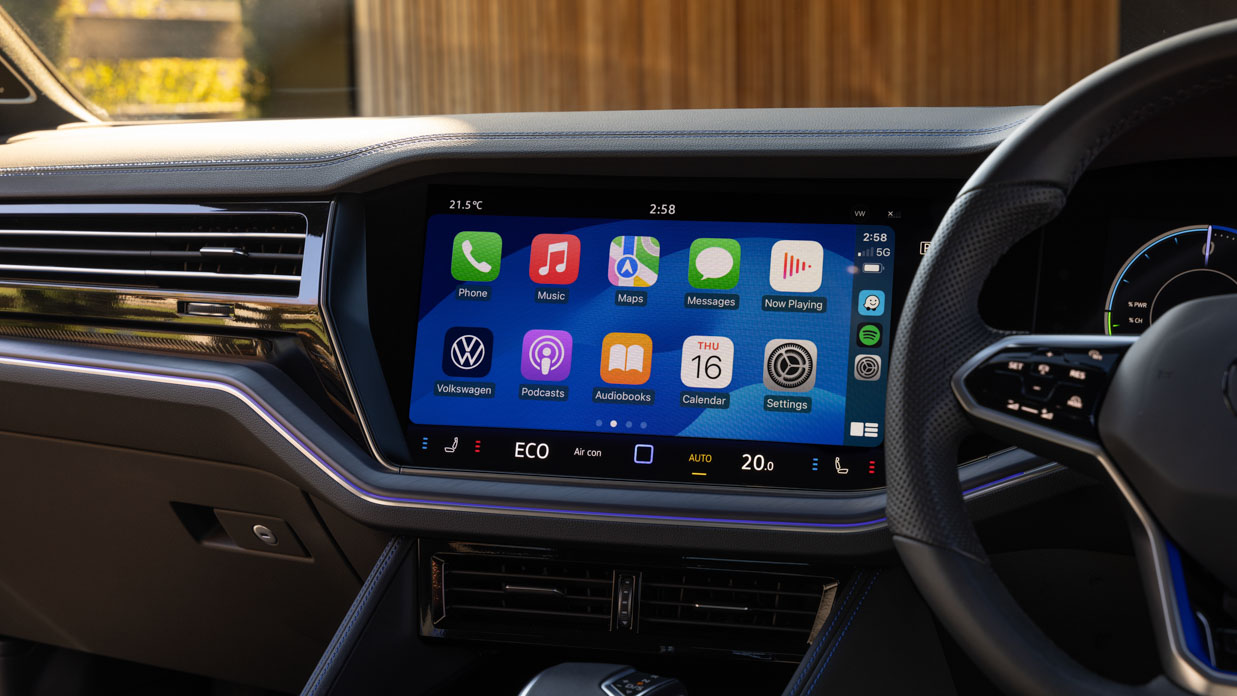
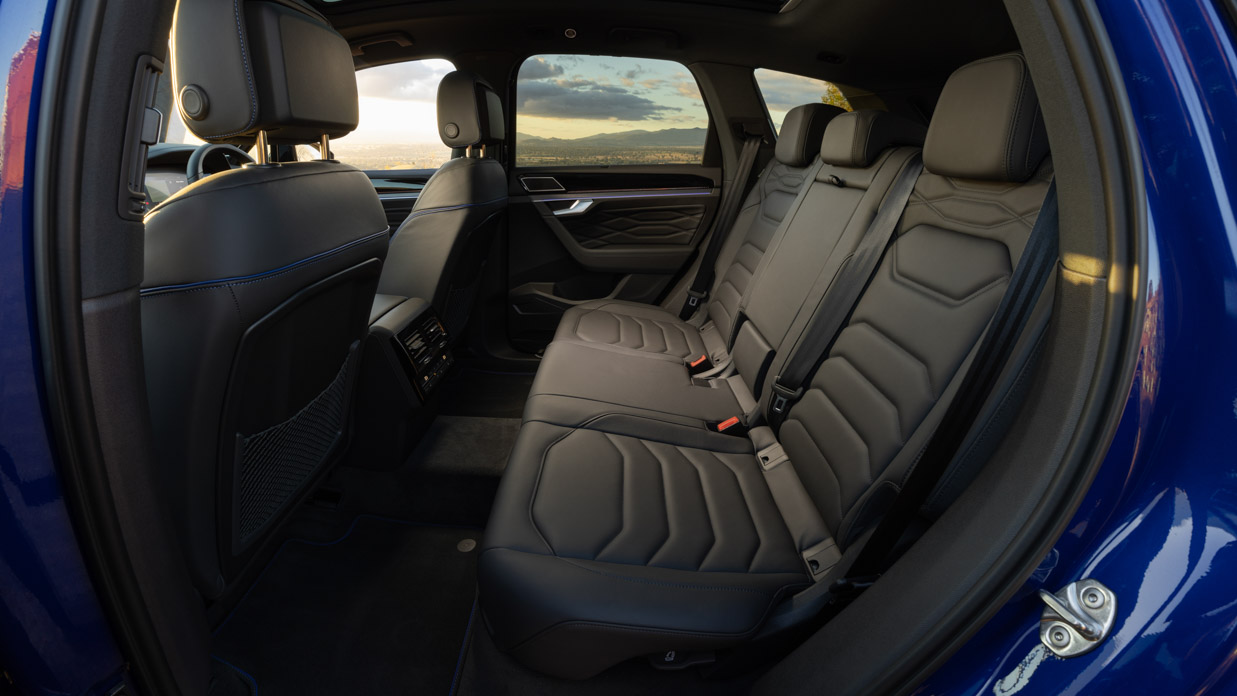
Sadly there are still some odd elements to this display, such as how the rest of the screen is ‘blacked out’ when the driver wants to adjust their temperature slider on the bottom corner of the screen, or when the passenger turns on their massage function.
It’s a minor annoyance and you can work around it, but when the rest of the vehicle displays such attention to detail, small misses like this are more frustrating than in lesser cars.
The five-seat-only Touareg goes some way to make up for its lack of a third row with its huge 810L boot, which expands to 1800L when the rear seats are down.
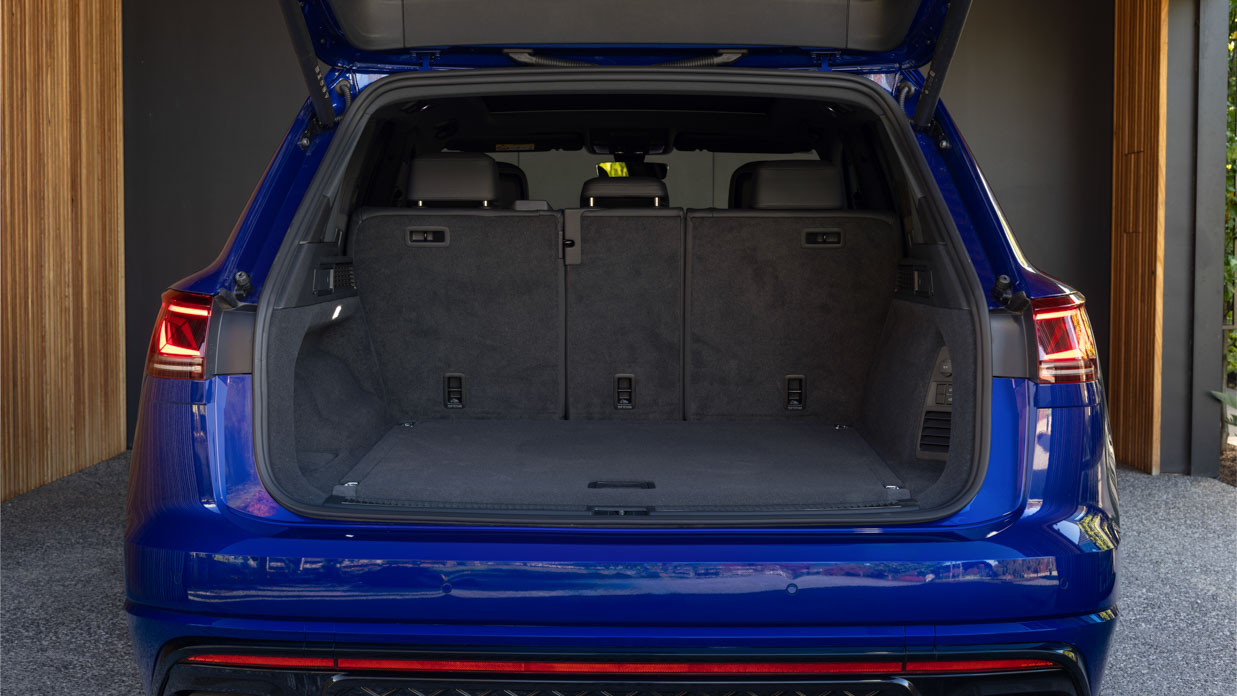
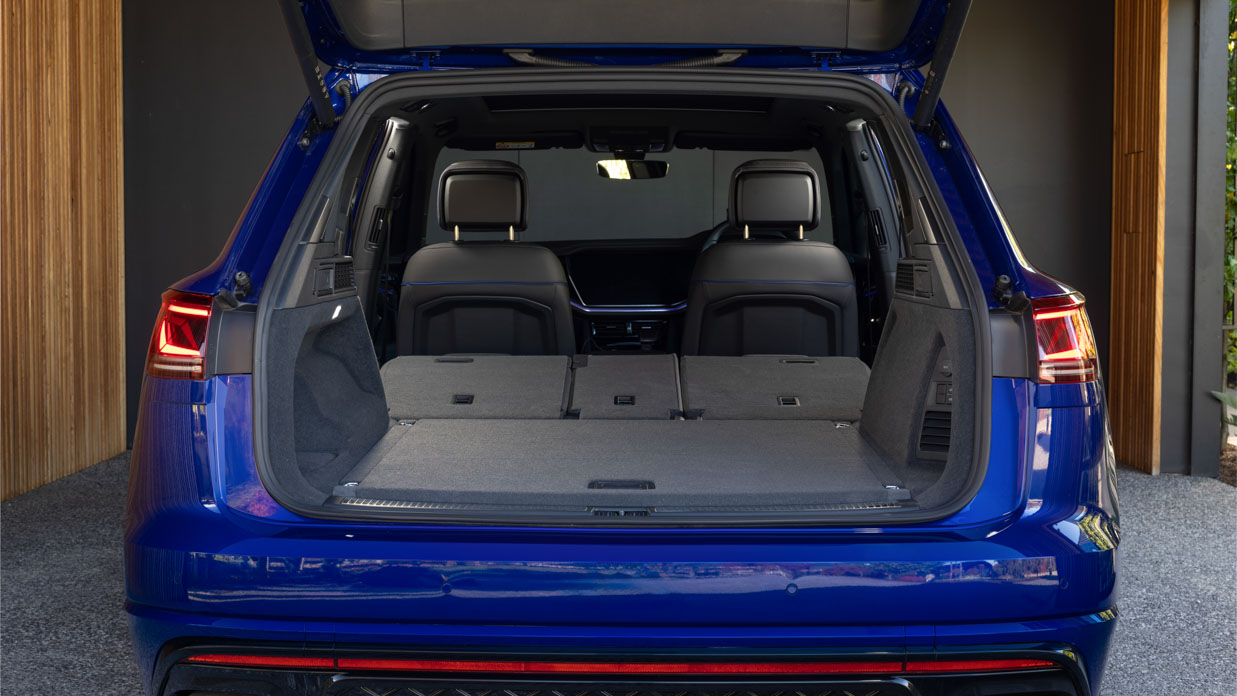
But hampering its grand touring ability is the lack of any spare wheel. Diesel Touaregs have a space-saver (not ideal, but it’s something), but the hybrid loses this security with only a tyre repair kit. This isn’t uncommon for a performance SUV on huge wheels, but when the boot is so large there should be room for compromise.
In terms of running costs, the Touareg R has servicing intervals of every 15,000km or 12 months and a pre-paid service package will set buyers back $3400 over five years, which is a handy $100 less than a regular diesel Touareg. Warranty coverage extends to five years / unlimited kilometres.
The Touareg R is an impressive vehicle that shows its breadth of ability across a number of disciplines, both fun and functional.
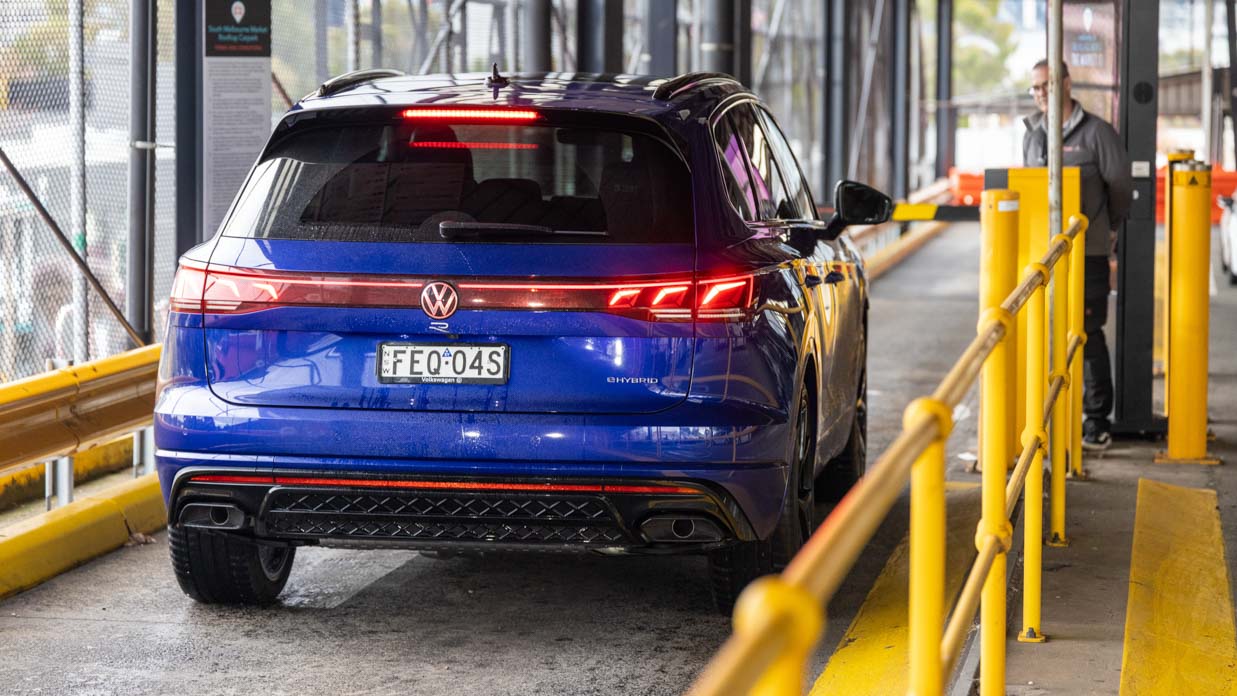
Compromises are so few and far-between that it is actually easy to forget this is a fully-fledged R product – not a letter commonly associated (yet) with air-sprung and smooth ride quality, genuine EV-only range, and a 3500kg towing capability (albeit with 215kg tow ball limit).
With strict combustion emissions laws already a reality in Europe and nearly in force in Australia, PHEV-powered performance is the movement of the moment.
The Touareg R isn’t alone in adding a plug to prolong potent petrol power – but it is one of the more miserly entrants. There’s the aforementioned BMW X5 xDrive50e ($149,900), Range Rover Sport P460e ($178,650), and even the new Mercedes-AMG GLC63 ($192,900).
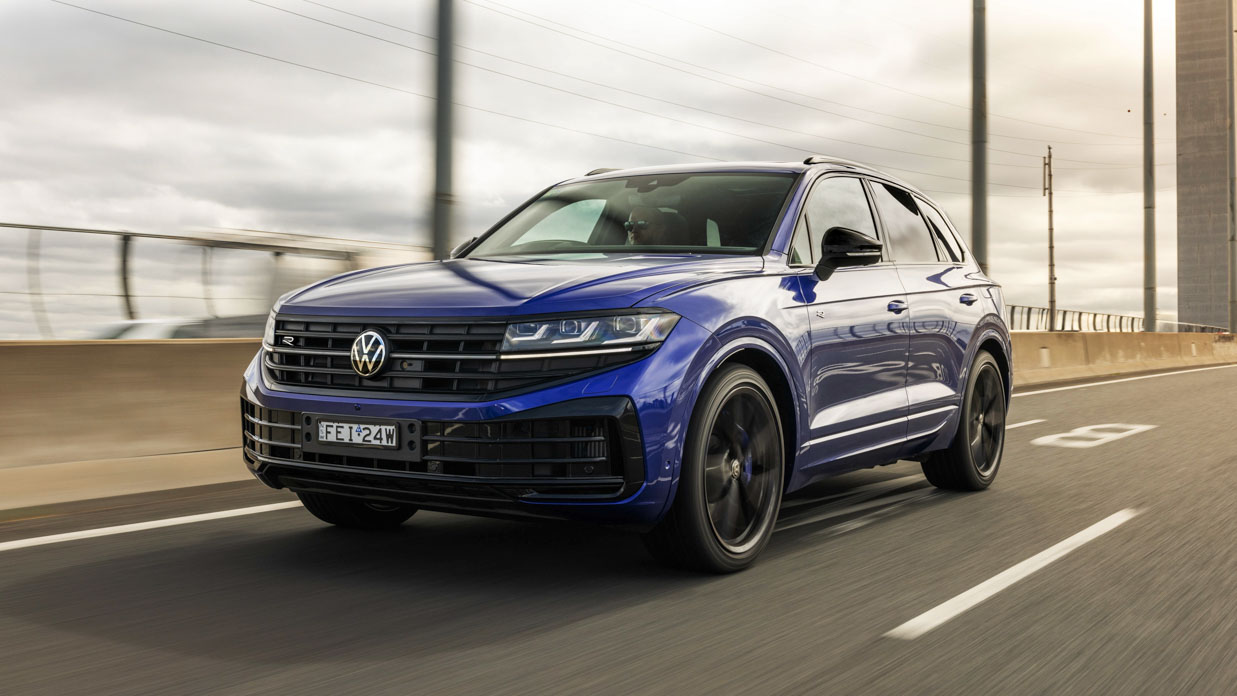
Similar to the Merc, the Touareg has forgone some of its cylinder count in favour of plug-in hybrid performance – but while Volkswagen stepped from a V8 to a V6, the Mercedes halved its girth – the bent-eight giving way to a hybrid 2.0-litre four-cylinder… albeit one making 500kW of power.
These vehicles are the messengers of a new era in petrol performance: one that requires a useful amount of potential electric range just to be sold in this country. Expect to see much more of it as manufacturers experiment to skirt big emissions-related fines.
While some products in the emerging hybrid performance space feel hampered by extreme compromise, the good news for Touareg fans is that the plug-in R manages this duality very well indeed.
Key specs (as tested)
About Chasing cars
Chasing Cars reviews are 100% independent.
Because we are powered by Budget Direct Insurance, we don’t receive advertising or sales revenue from car manufacturers.
We’re truly independent – giving you Australia’s best car reviews.
The estimate provided does not take into account your personal circumstances but is intended to give a general indication of the cost of insurance, in order to obtain a complete quote, please visit www.budgetdirect.com.au. Estimate includes 15%^ online discount.
^Conditions Apply
Budget Direct Insurance arranged by Auto & General Services Pty Ltd ACN 003 617 909(AGS) AFSL 241 411, for and on behalf of the insurer, Auto & General Insurance Company Limited(ABN 42 111 586 353, AFSL 285 571).Because we don’t know your financial needs, we can’t advise you if this insurance will suit you. You should consider your needs and the Product Disclosure Statement before making a decision to buy insurance. Terms and conditions apply.
Indicative quote based on assumptions including postcode , 40 year old male with no offences, licence suspensions or claims in the last 5 years, a NCD Rating 1 and no younger drivers listed. White car, driven up to 10,000kms a year, unfinanced, with no modifications, factory options and/or non-standard accessories, private use only and garaged at night.
^Online Discounts Terms & Conditions
1. Discounts apply to the premium paid for a new Budget Direct Gold Comprehensive Car Insurance, Third Party Property Only or Third Party Property, Fire & Theft Insurance policy initiated online on or after 29 March 2017. Discounts do not apply to optional Roadside Assistance.
2. Discounts do not apply to any renewal offer of insurance.
3. Discounts only apply to the insurance portion of the premium. Discounts are applied before government charges, taxes, levies and fees, including instalment processing fees (as applicable). The full extent of discounts may therefore be impacted.
4. We reserve the right to change the offer without notice.